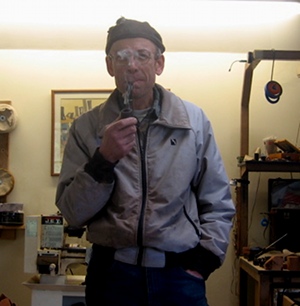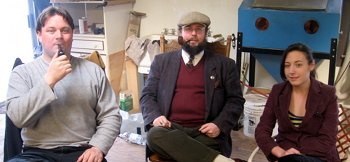 The bright afternoon sun filtered through the Lodgepole and Ponderosa pine to illuminate the workshop of pipemaker Brad Pohlmann. Though it looks to be a classic false-fronted shop out of the Wild West, it was created relatively recently by the former owner of the property as a painting studio for his wife. Now, it is filled with the tools of a master pipemaker. The walls are sparsely adorned with pipes and smoking memorabilia, and boxes of briar blocks sit beneath smoke-filmed windows that look out over Pohlmann's beautiful Applegate-valley property.
The bright afternoon sun filtered through the Lodgepole and Ponderosa pine to illuminate the workshop of pipemaker Brad Pohlmann. Though it looks to be a classic false-fronted shop out of the Wild West, it was created relatively recently by the former owner of the property as a painting studio for his wife. Now, it is filled with the tools of a master pipemaker. The walls are sparsely adorned with pipes and smoking memorabilia, and boxes of briar blocks sit beneath smoke-filmed windows that look out over Pohlmann's beautiful Applegate-valley property.The three of us had loaded our bags with beer, tobacco, and the trappings of smokers, and made the long-overdue drive to the valley to visit Pohlmann. We used the excuse of celebrating his selection as Pipes & Tobaccos Magazine's Pipemaker of the Year, and the arrival of Daylight Savings Time, but in truth, we'd been planning to visit him for quite a while, and were just now getting around to it. Pohlmann moved to the Applegate Valley in Oregon in 2004, and sometime in 2006 or 2007, Jesse Williamson came to me eagerly, that excited gleam in his eye, saying, "Erik, I've discovered a pipemaker! He lives here!"
Pohlmann shares with us a love of fine bourbon and fine beer, just as we share his passion for tobacco and pipes. But his is a true passion, and though pipemaking is his living, it is also one of his great loves. I myself have two Pohlmann pipes, though one of them is a very early, nearly discarded specimen with a pre-fabricated stem. This doesn't stop it from being my most-used pipe, and the constant attention is apparently starting to show. That afternoon, I took the pipe from my bag, but before I could pack any Broken Scotch Cake into its bowl, Pohlmann had taken it from my hands.
His own pipe puffing away, the master craftsman held mine up to the light. He examined it for just a moment before, wordlessly, he went to work polishing and buffing the tarnished, dented, chewed-on stem. He hunched over a buffing wheel attached to a lathe, and explained, "These pre-made mouthpieces oxidize so badly!" In five minutes, the pipe was back in my hand. The black stem gleamed, with even my toothmarks nearly eradicated. When I admired the work, Pohlmann reached for the pipe again. "Oh, I can take the toothmarks all the way out if you'd like."
 "No, that's all right," I said, clutching the pipe to my chest. "I'll just chew them back in again." Plus, I wanted to smoke. Pohlmann's pipes, even without his hand-made ebonite stems, smoke incredibly.
"No, that's all right," I said, clutching the pipe to my chest. "I'll just chew them back in again." Plus, I wanted to smoke. Pohlmann's pipes, even without his hand-made ebonite stems, smoke incredibly.
So the four of us relaxed in the workshop, slowly suffusing the atmosphere with a Holmsian haze. A hutch against one wall displayed a rack of perhaps 20 pipes, pyramids of Rattray canisters dating back to the early 20th century, and boxes and jars filled with flake tobacco that Pohlmann had accidentally won in a trivia contest.
"I got a call from Sykes [Wilford of SmokingPipes.com]," Pohlmann explains. "I'd won the contest for a free pipe. He said it would be like coals to Newcastle, and offered free tobacco instead." He rubbed out some beautiful navy flake onto a silver tray and passed around. The atmosphere, in the meantime, became thicker. The sunbeams coming in through the window were now visible.
We were into our second bowls of tobacco when Pohlmann started talking about the process of crafting the Pipes of the Year. He made 50 of the same shape, some sandblasted and some smooth. The level of detail and perfection is amazing, and sitting next to his workbench was a box full of discards. With some, the shape of a pipe was just beginning to emerge from a block of briar, while in others he had nearly finished a piece before revealing a fatal flaw in the wood. He showed us one of the rejects, lamenting, "Look at the grain here, and this beautiful birdseye." It was a beautiful pipe, but inside the bowl was an inexcusable blemish.
Pohlmann's eye for shape and design is difficult to match. He showed us some early designs of his, explaining how he didn't like one because of the way the shape of a ridge didn't match the grain of the wood. It was a flaw I hadn't noticed until he mentioned it, but once he did, it stood out plainly.
I remember when Pohlmann had begun working on the Pipe of the Year, because his periodic visits into town, when we would sit on Jesse's porch drinking bourbon and smoking cigars, had become far less frequent. When we did see him, he'd shake his head and say, "Boy, let me tell you, I have been so busy." But for quite a while he was quiet about what was keeping him so busy, and it wasn't until shortly before the official announcement that he let us in on the secret: he'd been selected as Pipemaker of the Year by Pipes & Tobacco Magazine. But we weren't allowed to tell anybody.
Eventually, our eyes bleary from smoke and the far walls just barely visible through the tobacco haze, we stepped out into the sunshine. Spring was nearly upon us. The oak trees had not yet begun to bud, but wildflowers were poking up through the grass and brambles. We wandered up the hillside through thickets of oak and madrone, pipes still puffing away. What greater leisure could there be than to spend one's days in such an idyllic setting, pursuing perfection through such a beloved craft?
As the Sun grew low on the horizon and our supply of beer dwindled, we realized it was time to head home. We said our goodbyes and piled into the car, our pipes empty, but not for long.
His own pipe puffing away, the master craftsman held mine up to the light. He examined it for just a moment before, wordlessly, he went to work polishing and buffing the tarnished, dented, chewed-on stem. He hunched over a buffing wheel attached to a lathe, and explained, "These pre-made mouthpieces oxidize so badly!" In five minutes, the pipe was back in my hand. The black stem gleamed, with even my toothmarks nearly eradicated. When I admired the work, Pohlmann reached for the pipe again. "Oh, I can take the toothmarks all the way out if you'd like."
 "No, that's all right," I said, clutching the pipe to my chest. "I'll just chew them back in again." Plus, I wanted to smoke. Pohlmann's pipes, even without his hand-made ebonite stems, smoke incredibly.
"No, that's all right," I said, clutching the pipe to my chest. "I'll just chew them back in again." Plus, I wanted to smoke. Pohlmann's pipes, even without his hand-made ebonite stems, smoke incredibly.So the four of us relaxed in the workshop, slowly suffusing the atmosphere with a Holmsian haze. A hutch against one wall displayed a rack of perhaps 20 pipes, pyramids of Rattray canisters dating back to the early 20th century, and boxes and jars filled with flake tobacco that Pohlmann had accidentally won in a trivia contest.
"I got a call from Sykes [Wilford of SmokingPipes.com]," Pohlmann explains. "I'd won the contest for a free pipe. He said it would be like coals to Newcastle, and offered free tobacco instead." He rubbed out some beautiful navy flake onto a silver tray and passed around. The atmosphere, in the meantime, became thicker. The sunbeams coming in through the window were now visible.
We were into our second bowls of tobacco when Pohlmann started talking about the process of crafting the Pipes of the Year. He made 50 of the same shape, some sandblasted and some smooth. The level of detail and perfection is amazing, and sitting next to his workbench was a box full of discards. With some, the shape of a pipe was just beginning to emerge from a block of briar, while in others he had nearly finished a piece before revealing a fatal flaw in the wood. He showed us one of the rejects, lamenting, "Look at the grain here, and this beautiful birdseye." It was a beautiful pipe, but inside the bowl was an inexcusable blemish.
Pohlmann's eye for shape and design is difficult to match. He showed us some early designs of his, explaining how he didn't like one because of the way the shape of a ridge didn't match the grain of the wood. It was a flaw I hadn't noticed until he mentioned it, but once he did, it stood out plainly.
I remember when Pohlmann had begun working on the Pipe of the Year, because his periodic visits into town, when we would sit on Jesse's porch drinking bourbon and smoking cigars, had become far less frequent. When we did see him, he'd shake his head and say, "Boy, let me tell you, I have been so busy." But for quite a while he was quiet about what was keeping him so busy, and it wasn't until shortly before the official announcement that he let us in on the secret: he'd been selected as Pipemaker of the Year by Pipes & Tobacco Magazine. But we weren't allowed to tell anybody.
Eventually, our eyes bleary from smoke and the far walls just barely visible through the tobacco haze, we stepped out into the sunshine. Spring was nearly upon us. The oak trees had not yet begun to bud, but wildflowers were poking up through the grass and brambles. We wandered up the hillside through thickets of oak and madrone, pipes still puffing away. What greater leisure could there be than to spend one's days in such an idyllic setting, pursuing perfection through such a beloved craft?
As the Sun grew low on the horizon and our supply of beer dwindled, we realized it was time to head home. We said our goodbyes and piled into the car, our pipes empty, but not for long.

 By
By 















Leave a comment